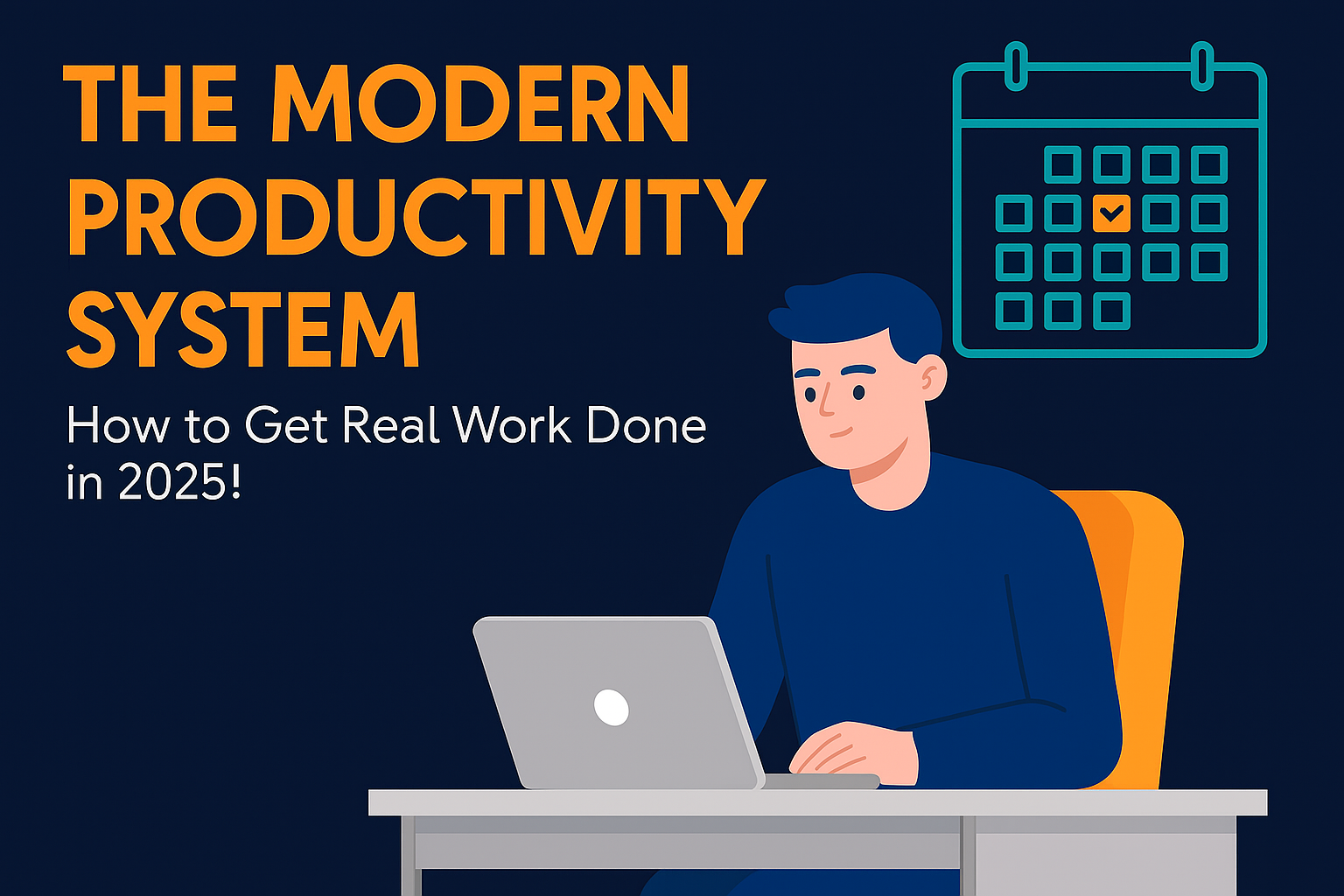A fresh, original guide with practical habits, systems, and a 12-week plan to help busy people produce high-impact results — without burning out.
Introduction — What Productivity Really Means
Most articles treat productivity as “do more.” This guide starts from a different place: productivity = producing more of what matters. That means fewer tasks, clearer goals, and better energy allocation. It’s not about packing your day; it’s about shipping valuable outcomes with less friction.
In 2025 the environment looks different: attention is fractured across short video, notifications, instant collaboration, and AI tools that can draft, summarize, and automate parts of your work. The right system turns these changes into advantages. This article gives you the mental models, routines, and a 12-week plan to make that happen.
Core Principles
- Focus on outputs, not inputs. Track shipped outcomes (a completed article, a launched feature, a signed client), not hours spent.
- Design your environment: Remove friction for focus and automate the rest.
- Protect high-value time: Schedule blocks when your energy is highest for deep work.
- Use constraints: Deadlines, time-boxes, and narrow scopes increase creativity.
- Iterate fast: Small experiments win over prolonged overplanning.
Mindset shift: treat productivity as a system — inputs (sleep, food, tools), processes (rituals, planning, focus), and outputs (deliverables). Optimize each layer.
Energy Management — The Foundation Often Overlooked
Energy governs focus. You can gain a 2x improvement in output by managing sleep, hydration, and short recovery rituals — without changing your schedule.
Daily energy checklist
- Sleep: aim for consistent bed/wake times; track patterns for two weeks and adjust.
- Morning routine: 5–15 minutes of sunlight + movement to signal your circadian clock.
- Hydration & protein at the start of the day. Small protein-rich breakfast stabilizes attention for hours.
- Movement breaks: 10 minutes every 90 minutes for circulation and brain refresh.
- Micro-naps: a 12–20 minute nap early afternoon can improve cognition (if your schedule permits).
Weekly energy resets
- One active recovery day: longer walk, light exercise, and social time — not work.
- One digital Sabbath block (4–6 hours) with notifications off and no async work.
Focus Systems — How to Protect Deep Work
Deep work is the state where you produce meaningful outputs. The key is both structure and signals: constraints that tell your brain to commit.
Block scheduling
Schedule 2–4 deep blocks per week of 60–120 minutes. Guard them: no meetings, no email, no chat. Use calendar color-coding and communicate these blocks to teammates.
Rituals that start focus
- 5-minute micro-ritual: close tabs, open the single document, set the timer for the block, and write one sentence summarizing the goal.
- Use a physical or visual cue: a closed door, headphones, or a small desk sign that signals “do not disturb.”
Technique toolbox
- Pomodoro variant: 50 min work / 10 min break for deep focus blocks.
- Time boxing: commit to shipping a result in a fixed time window.
- Batching: group similar tasks to cut context switching (e.g., email only twice a day).
- Single-task commitment: Work on one outcome until it reaches a natural stopping point.
Planning & Execution — From Vision to Daily Action
Good planning answers three questions: What matters? Why it matters? What is the smallest action that moves the needle?
Decision-making hierarchy
- Annual goals: 1–3 high-level objectives with measurable outcomes.
- Quarterly projects: 1–2 projects per goal that deliver visible progress.
- Weekly priorities: 3 outcomes to accomplish this week that move projects forward.
- Daily check: 1–2 “must ship today” tasks and a small list of “fast wins” under 20 minutes.
Weekly planning ritual (45 minutes)
- Review progress on quarterly projects.
- Choose 3 weekly priorities (no more).
- Schedule deep work blocks for the week aligned with priority tasks.
- Plan one learning slot — 30–60 minutes for skill growth.
Daily execution ritual (10 minutes)
- Morning 3-minute check: confirm today’s top 1–2 tasks and the time block for each.
- Evening 5-minute review: what shipped, what blocked you, and one adjustment for tomorrow.
Tools & Automation — Choose Less, Use Well
Tools are amplifiers. The problem is tool-bloat; the solution is reducing cognitive overhead and automating repeatable tasks.
Essential tool categories
- Calendar: a reliable calendar with color-coded blocks (e.g., Google Calendar).
- Task manager: one system for outcomes (e.g., Todoist, Things, Notion; use features sparingly).
- Notes & reference: a searchable, linked knowledge base (Obsidian or Notion).
- Communication: Slack or Teams with muted notifications and configured Do Not Disturb windows.
- Automation: Zapier, Make, or simple scripts for repetitive moves.
AI to save time — where it helps
- Drafting first drafts: prompts for outlines and rough drafts, always human-refine before publish.
- Summaries and meeting notes: use transcription + summary tools to capture decisions.
- Email triage: generate reply templates and refine them; never fully automate critical communications.
- Data extraction: glue tools to extract and structure data from invoices or forms.
Tool pairing rule
Pair one planning tool, one execution tool, and one reference tool. If a tool overlaps functionally, pick the simplest and commit.
Collaboration & Delegation — Multiply Your Impact
Great solo productivity is useful, but most lasting results require collaboration. Delegation is the multiplier that scales your output.
Principles of effective delegation
- Delegate outcomes, not tasks: explain the desired result, criteria for success, and deadline.
- Start with small tasks: build trust with short handoffs, then increase scope.
- Document the process: the first time you delegate, capture steps to reduce repeat explanations.
Efficient meetings
- Only invite decision-makers and people who will act on the meeting outcome.
- Share an agenda 24 hours before with clear desired outputs.
- End with assigned owners and deadlines; record decisions in a shared doc.
Habits & Rituals — The Small Things That Compound
Systems are behaviors repeated until they produce predictable outcomes. A few rituals reduce decision fatigue and maintain momentum.
Powerful micro-habits (5–15 minutes)
- Morning 5-minute clarity: write today’s top outcome and one obstacle; visualize completion.
- End-of-day 10-minute triage: clear inbox to 10, write one batched task list for tomorrow.
- Weekly learning: 60 minutes per week to read, practice or watch tutorials.
- Weekly planning: 45 minutes to set priorities and protect deep work blocks.
Habit stacking
Attach new habits to existing routines. Example: after brush teeth (existing cue), open your planner and pick the top 1 task (new habit).
Measure What Matters — Outcomes Over Activity
Measurement keeps you honest. But measurement for measurement’s sake wastes time. Track a handful of metrics that reflect real value.
Example personal metrics
- Weekly shipped outcomes (articles, sales calls closed, features released).
- Hours of deep work per week (targets: 6–12 depending on role).
- Focus ratio: deep work hours / total work hours.
- Energy score: subjective daily rating 1–5 to correlate with output.
Use simple dashboards
A single spreadsheet or one Notion page that shows weekly targets and results is enough. Reviewing it in your weekly ritual drives continuous improvement.
12-Week Plan to Ship Something Meaningful
This practical plan helps you move from idea to a shipped deliverable in twelve weeks. The goal: one meaningful outcome (a course, a product feature, a marketing campaign) that you can iterate on.
Overall cadence
The plan uses three 4-week sprints. Each week has a clear outcome and a protected deep work block.
Sprint 1 — Discover & Define (Weeks 1–4)
- Week 1: Problem interviews (5–10 conversations) and decide on one concrete deliverable.
- Week 2: Outcome definition & success criteria; write a one-page brief.
- Week 3: Prototype / outline; small “pre-sell” landing page or demo.
- Week 4: Early validation (collect 20–200 visitors or 5 pre-commitments) and iterate brief.
Sprint 2 — Build & Test (Weeks 5–8)
- Week 5: Build MVP / record core content (30–60% of final scope).
- Week 6: User testing and feedback sessions; fix highest-value issues.
- Week 7: Polish & prepare launch materials (marketing copy, hero image, email sequence).
- Week 8: Soft launch to early adopters; collect metrics and testimonials.
Sprint 3 — Launch & Iterate (Weeks 9–12)
- Week 9: Public launch; measure conversion & feedback.
- Week 10: Focus on retention and initial monetization experiments.
- Week 11: Optimize top funnel and onboarding steps based on data.
- Week 12: Reflect, document learnings, plan next 12 weeks (scale or pivot).
Short Case Studies — How People Applied the System
Case: The Solo Creator Product
A content creator validated an online workshop by surveying her email list (n=120), built a 90-minute pilot, sold 30 seats for $39 each, and used feedback to build a paid 3-hour course. Key moves: early commitment, focused launch, and one clear promise.
Case: The Product Manager’s Deep-Work Fix
A PM moved two daily standups into a single triage meeting and created two weekly 2-hour blocks for roadmap work. Output doubled: two features shipped in a quarter that improved activation by 12%.
Case: Small Agency That Scaled Without Hiring
An agency standardized proposals and created templated deliverables. By delegating template execution to a virtual assistant and using a simple automation pipeline, they increased proposal throughput by 3x and won more projects without hiring full-time staff.
FAQ & Pitfalls
Q: I can’t find time for deep work. What do I do?
A: Start by protecting one 60-minute block per week and treat it like a meeting. Gradually increase blocks and eliminate low-value meetings.
Q: Tools don’t help — I get distracted more. Why?
A: Tools amplify existing habits. If your habit is distraction, a tool that surfaces more notifications will worsen it. Use Do Not Disturb, mute non-essential channels, and pick one tool per problem.
Common pitfalls
- Measuring busyness instead of results — track outcomes.
- Chasing perfect systems — iterate fast with imperfect tools.
- Neglecting recovery — productivity without recovery is burnout in slow motion.
Conclusion & Next Actions
Productivity in 2025 is about designing life-friendly systems: protect your energy, prioritize meaningful outcomes, and use simple tools to remove friction. You don’t need more time; you need focused time on the right things with repeatable processes.
Your next 7-day sprint (practical)
- Set one meaningful 12-week outcome and write it in one sentence.
- Block three weekly deep work sessions in your calendar for the next two weeks.
- Run three problem interviews (15 minutes each) related to your outcome.
- Automate one repetitive task (email template, recurring transfer, or a simple Zap).
- Report back to yourself: after 7 days write a 100-word summary of what changed.
If you’d like, I can create a custom 12-week plan tailored to one specific outcome you choose. Tell me the one sentence outcome and I’ll draft the plan.



